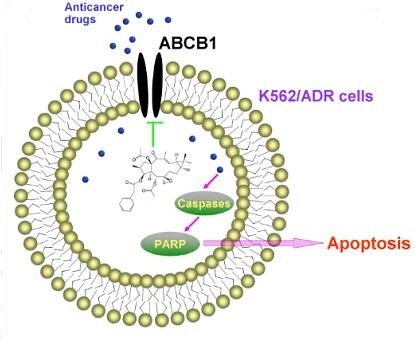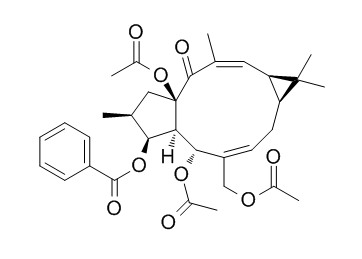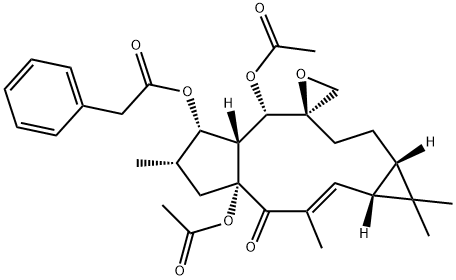Euphorbia factor L1—a multi-functional diterpenoid
Biological Effects
Euphorbiasteroid, Euphorbia Factor L1 (EFL1) to be specific, with a tricyclic terpenoid skeleton, consisting of fused five-, eleven- and three-membered rings, is a diterpenoid isolated from the seeds of Euhporbia lathyris L. It is reported EFL1 could be helpful to reduces the expression of Bcl-2, PI3K, AKT and mTOR protein and mRNA, upregulates cleaved caspase-9 and caspase-3 levels, but shows no effect on pro-caspase-9 and pro-caspase-3. EFL1 also could induce apoptosis, and possess anticancer, antiadipogenesis, antiosteoclastogenesis and multi-drug resistance-modulating effect.
Euphorbiasteroid showed effects on adipogenesis of 3T3-L1 pre-adipocytes. EFL1 decreased differentiation of 3T3-L1 cells via reduction of intracellular triglyceride (TG) accumulation at concentrations of 25 and 50 μM. In addition, EFL1 altered the key regulator proteins of adipogenesis in the early stage of adipocyte differentiation by increasing the phosphorylation of AMP‐activated protein kinase (AMPK) and acetyl‐CoA carboxylase. Subsequently, levels of adipogenic proteins, including fatty acid synthase, peroxisome proliferator‐activated receptor‐γand CCAAT/enhancer‐binding protein α, were decreased by EFL1 treatment at the late stage of adipocyte differentiation. The anti‐adipogenic effect of Euphorbiasteroid may be derived from inhibition of early stage of adipocyte differentiation. Taken together, Euphorbiasteroid inhibits adipogenesis of 3T3‐L1 cells through activation of the AMPK pathway. Therefore, EFL1 and its source plant, E. lathyris L., could possibly be one of the fascinating anti-obesity agents.
Restoring the Toxicities of Anticancer Drugs

Euphorbiasteroid also has the potential to reverse P-glycoprotein (P-gp)-mediated multi-drug resistance (MDR) by using the drug-sensitive human sarcoma cell line MES-SA and its MDR counterpart MES-SA/Dx5. Interestingly, even at low concentrations, it efficiently restored the toxicities of anticancer drugs including vinblastine, taxol and doxorubicin in MES-SA/Dx5 cells. Additionally, the computational Bayesian model for predicting potential P-gp substrates or inhibitors revealed that EFL1 showed 97% probability for substrate likeness having similar molecular features with 50 P-gp substrates. Consistent with this result, the substrate likeness of EFL1 was also experimentally confirmed by P-gp ATPase activity assay. In conclusion, EFL1 could be a transport substrate for P-gp that can effectively inhibit P-gp-mediated drug transport and reverse resistance to anticancer drugs in MES-SA/Dx5 cells.
EFL1 inhibited osteoclastogenesis and induced osteoclast apoptosis. Euphorbiasteroid suppressed osteoclast formation and bone resorption at both initial and terminal differentiation stages. Euphorbiasteroid inhibited receptor activator of NF-κB ligand (RANKL)-induced NFATc1 induction with attenuated NF-κB activation and c-Fos expression. EFL1 decreased the level of reactive oxygen species by scavenging them or activating Nrf2, and inhibited PGC-1β that regulates mitochondria biogenesis. In addition, EFL1 induced apoptosis in differentiated osteoclasts by increasing Fas ligand expression followed by caspase activation. Moreover, Euphorbiasteroid inhibited inflammation-induced bone erosion and ovariectomy-induced bone loss in mice. These findings suggest that Euphorbiasteroid inhibits osteoclast differentiation by regulating cellular redox status and induces Fas-mediated apoptosis in osteoclast, and may provide therapeutic potential for preventing or treating bone-related diseases caused by excessive osteoclast.
References
[1]. Park SJ, et al. Euphorbiasteroid, a component of Euphorbia lathyris L., inhibits adipogenesis of 3T3-L1 cells via activation of AMP-activated protein kinase. Cell Biochem. Funct., 2015, 33(4):220-5.
[2]. Jung Sook Choi, et al. Euphorbiasteroid reverses P‐glycoprotein‐mediated multi‐drug resistance in human sarcoma cell line MES‐SA/Dx5.Phytotherapy research. 2010, 24(7):1042-1046.
You may like
See also
Lastest Price from Euphorbiasteroid manufacturers

US $9.00/kg2025-04-21
- CAS:
- 28649-59-4
- Min. Order:
- 1kg
- Purity:
- 0.99
- Supply Ability:
- 10000

US $1.00/KG2025-04-21
- CAS:
- 28649-59-4
- Min. Order:
- 1KG
- Purity:
- 99%
- Supply Ability:
- 10 mt



